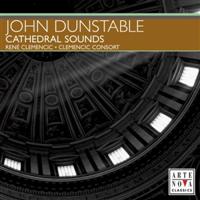There is a long stretch between the earliest known polyphony—the works of Perotin and the other masters of the Notre Dame school—and the next high point in the 15th century with the works of Ockeghem, Obrecht, and others. In between lie the Black Death, the birth of the Renaissance, and other major cultural developments, of course; musically there is a school of early polyphony called the contenance angloise, literally the “English guise,” so named because the composers on the Continent who adopted the English techniques were said to be putting on an English face. Without the composers of this school, the course of the evolution of Western music would be dramatically altered. With this background, this recording of the works of John Dunstable, foremost composer of the contenance angloise, takes on historic significance.
Even without the historical setting, this recording earns its musical significance on its own merits and on superlative performances by the Clemencic Consort. The ensemble, comprising three male voices and Dr. René Clemencic on a reproduction positive organ, is superbly tight, and the polyphony is rich and vibrant. In fact, the musical ideas in the polyphony, including the use of Gregorian melodies as a cantus firmus on which the piece is built, are consonant with the work of composers who flourished a hundred years or more later. It is difficult to remember that this music, which sounds as though it came from the height of the Renaissance, was written within fifty years of the plague’s devastation. Dunstable’s work is thought to be influenced by contemporary understandings of astronomy—one of the few surviving artifacts that attests to his existence (many of his scores having perished during the Dissolution of the Monasteries) is a note in his hand in a book on astronomy at Cambridge. Whatever the source for his inspiration, his music is presented on this recording with warmth and humanity.
Allegro Music is reissuing a number of other pivotal recordings from the Arte Nova label (this recording was originally released in 1995), and on the basis of this performance the rest of the series is certainly worth checking out.
Originally published at Blogcritics.

